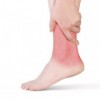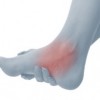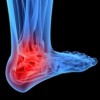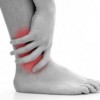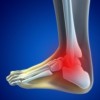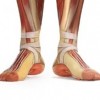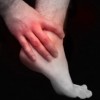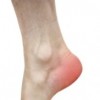Ankle & Foot
Tibialis anterior tendonitis is a common injury normally seen in individuals who partake in athletic sports that involve repetitive or forceful upwards flexion of the ankle and foot. Typically activities like uphill or downhill running and sprinting, walking on uneven surfaces and sports such as snowboarding (long periods on toe side) can trigger the onset.
Symptoms begin with a dull ache around the front of the ankle that gradually worsens over a course of 2-3 weeks. In some cases the discomfort is only felt on ankle dorsiflexion, when the tibialis anterior tendon is stressed, with others it is felt once resting after an activity. Stiffness and dull aches are normally experienced during the night and are most intense early in the morning. The pain and discomfort will often radiate from the front of the ankle, up into the lower leg and down into the top of the foot.
Tibialis posterior tendonitis is a common injury normally seen in individuals who partake in athletic sports that involve repetitive or forceful tilting inwards and downwards flexion of the ankle and foot.
Symptoms begin with a dull ache around the inside of the ankle that gradually worsens over a course of 2-3 weeks. In some cases the discomfort is only felt on ankle inversion or plantar flexion when the tibialis posterior tendon is stressed, with others it is felt once resting after an activity. Stiffness and dull aches are normally experienced during the night and are most intense early in the morning. The pain and discomfort will often radiate up into the inside of the lower leg or down into the top of the foot.
Posterior ankle impingement is a common injury and effects people of all ages. It is normally seen in individuals who partake in sports that involve repetitive or downwards flexion of the foot, such as football, gymnastics and ballet dancing.
Symptoms include intense immediate sharp pains or dull ache around the back of the ankle when flexing the foot in a downwards movement. Pain can be felt when simply weight bearing or when resting after an activity. Stiffness and dull aches are normally experienced during the night and are most intense early in the morning. The pain at the back of the ankle occasionally radiates up into the calf and down into the sole of the foot.
Peroneal tendonitis is a common injury normally seen in individuals who partake in athletic sports involving repetitive or forceful twisting of the ankle and foot to the side.
Symptoms begin as a dull ache around the outside of the ankle that gradually worsens over a course of 2-3 weeks. In some cases the discomfort will be felt on ankle eversion when the peroneal tendon is stressed and with others it is felt when resting after an activity. Stiffness and dull aches are normally experienced during the night and are most intense early in the morning. The pain and discomfort will often radiate up into the lower leg or down into the sole of the foot.
Anterior ankle impingement is a common injury and effects people of all ages. It is normally seen in individuals who partake in athletic sports that involve repetitive or forceful upwards flexion of the foot, for example running uphill or downhill, sprinting and landing from long jump.
Symptoms include intense immediate sharp pains or dull ache around the front of the ankle when flexing your foot towards your knee. Pain can be felt when simply weight bearing or when resting after an activity. Stiffness and dull aches are normally experienced during the night and are most intense early in the morning. The pain at the front of the ankle occasionally radiates up into the shin and down into the foot.
Ankle & Foot - Myofascial Pain Syndrome (muscle pain)
Myofascial pain (muscle pain) can result from sprains or strains of a joint, excessive repetitive movements and high stress levels. Risk factors like poor posture, fatigue, heavy lifting and even muscle weakness may make you more susceptible to myofascial pain. Specific causes like stress, normally cause quite a lot of tension in the upper back and neck which can then lead to quite bad headaches.
Symptoms range from a sudden sharp pain, spasms and burning pain to a gradual build-up of a dull ache and discomfort that is worse in the evening after long days at work or activity. Muscle knots and trigger points can cause pain to refer from the injured muscle to the surrounding areas.
Achilles tendonitis is a common injury normally seen in individuals who partake in a lot of athletic sports, in particular long distance running that involves repetitive or forceful stretching of the tendon.
Symptoms begin as a dull ache around the back of the ankle that gradually worsens over a course of 2-3 weeks. In some cases the discomfort is only felt when the Achilles tendon is stressed and with others it is felt when resting after an activity. Stiffness and dull aches are normally experienced during the night and are most intense early in the mornings. The pain and discomfort is not always restricted to the back of the ankle and often radiates up into the calf muscles of the lower leg or down into the sole of the foot.
Achilles bursitis most commonly occurs due to repetitive activity that encourages the calf muscles to tighten and shorten from overuse, like repetitively wearing high heels, running and even wearing tight shoes that pinch at the back of the heel.
Symptoms normally include a constant dull ache or burning pain at the back of the heel that is aggravated by any touch or pressure from tight shoes or movement of the ankle joint. There will normally be noticeable swelling around the back of the heel. In cases of bursitis caused by infection the skin around the affected joint will appear to be red and will feel incredibly warm to the touch with additional symptoms of a high temperature and feverish chills. Achilles Bursitis is very similar to retrocalcaneal bursitis as the bursae are very close in proximity and symptoms are almost identical, retrocalcaneal bursitis is more common.

